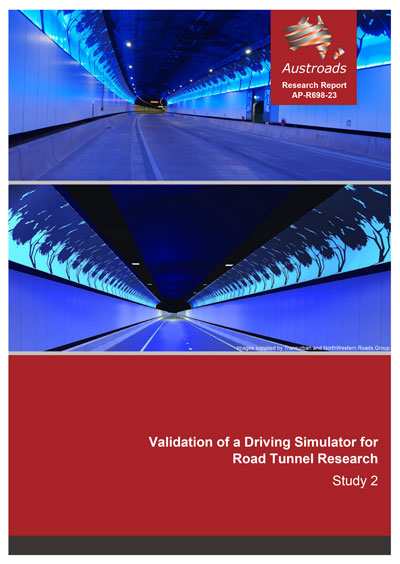Tunnels

- Publication no: AP-R698-23
- ISBN: 978-1-922994-07-3
- Published: 29 November 2023
- PDF (free) Download
This report documents the findings from a research study which aimed to validate the use of a virtual reality (VR) driving simulator to study driving behaviour in a real road tunnel. Specifically, it aimed to establish whether the simulator could be used as a safety-assured means of developing and testing in-tunnel aesthetic design features.
The north and southbound tunnels of the NorthConnex (NCX) tunnel, a 9-kilometre road tunnel in Sydney, Australia, were replicated in the VR driving simulator based on technical drawings and specifications provided by Austroads. Twenty-six participants drove through both the simulated and the real NCX tunnels.
The following driving-related data was collected in both the simulated and real tunnels: mean speed, standard deviation of speed, mean lateral lane position, and standard deviation of lateral lane position. In addition, drivers’ self-reported subjective perceptions of the two tunnel environments were measured. The data was analysed to determine whether there were any statistically significant differences between the simulated and real tunnels in these driving behaviour and performance metrics.
It is concluded that the VR driving simulator is a valid platform for the assessment of mean speed, speed variability, and mean lateral position. This is also the case for the assessment of drivers’ self-reported perceptions of the tunnel environment for the northbound NCX tunnel, and to a lesser extent for the southbound tunnel. Some recommendations are made for further research and for improving the validity of the driving simulator for use in road tunnel research.
For more information, watch a recording of the webinar below with Prof Michael (Mike) Regan, Dr Prasannah Prabhakharan, Julius Secadiningrat, Jack Mazaraki, Nicholas Rozenauers, Nigel Casey and Richard Merrett.
- Summary
- 1. Introduction
- 1.1 Purpose
- 1.2 Scope
- 1.3 Research Questions
- 1.4 Project Stages
- 2. Literature Review
- 3. Experiment Methodology
- 3.1 Experimental Design
- 3.2 Participants
- 3.3 Procedure
- 3.3.1 Instrumented Vehicle Driving Routes
- 4. Material & Apparatus
- 4.1 TRACSLab Driving Simulator
- 4.1.1 Simulator Hardware
- Virtual Reality (VR) headset
- 4.1.2 Simulator Software
- 4.1.3 Simulated 3D Tunnel Model and Scenario Development
- 4.2 Instrumented Vehicle
- 4.2.1 Test Vehicle
- 4.2.2 Data Collection Instrument
- 4.3 Questionnaires
- 4.3.1 Simulator Sickness Questionnaire
- 4.3.2 Questionnaire – Drive Experience
- 4.3.3 Questionnaire – Study Experience
- 4.1 TRACSLab Driving Simulator
- 5. Data Analysis Results
- 5.1 Datasets
- 5.2 Participant Demographics
- 5.3 Data Analysis Approach
- 5.4 Variables
- 5.4.1 Speed
- 5.4.2 Lateral Lane Position
- 5.5 Tunnel Segmentation
- 5.6 Validation of Speed
- 5.6.1 Mean Driver Speed
- 5.6.2 Standard Deviation of Driver Speed
- 5.7 Validation of Lateral Lane Position
- 5.7.1 Mean Lateral Lane Position
- 5.7.2 Standard Deviation of Lateral Lane Position
- 5.8 Drive Experience Questionnaires
- 6. Discussion
- 6.1 Mean Speed
- 6.1.1 Mean Speed - Northbound NCX Tunnel
- 6.1.2 Mean Speed – Southbound NCX Tunnel
- 6.1.3 Standard Deviation of Speed – Northbound NCX Tunnel
- 6.1.4 Standard Deviation of Speed – Southbound NCX Tunnel
- 6.2 Lateral Lane Position
- 6.2.1 Mean Lateral Lane Position – Northbound NCX Tunnel
- 6.2.2 Mean Lateral Lane Position – Southbound NCX Tunnel
- 6.2.3 Standard Deviation of Lateral Lane Position - Northbound NCX Tunnel
- 6.2.4 Standard Deviation of Lateral Lane Position - Southbound NCX Tunnel
- 6.3 Subjective Perception Questionnaires
- 6.3.1 Subjective Perception Questionnaires – Northbound NCX Tunnel
- 6.3.2 Subjective Perception Questionnaires – Southbound NCX Tunnel
- 6.4 Relative Validity
- 6.5 Relationship with Previous Findings
- 6.6 Limitations of the Present Study
- 6.7 Future Research
- 6.1 Mean Speed
- 7. Conclusion
- References
- Appendix A Testing Routes
- A.1 Instrumented car NB Instrumented car SB Driving simulator (NCX MCC)
- A.2 Instrumented car SB Instrumented car NB Driving simulator (NCX MCC)
- A.3 Driving simulator (NCX MCC) Instrumented car NB Instrumented car SB
- A.4 Driving simulator (NCX MCC) Instrumented car SB Instrumented car NB
- Appendix B Simulator Sickness Questionnaire
- Appendix C Drive Questionnaire
- Appendix D Post Study Questionnaires
- Appendix E Assumption Testing Results
- Appendix F Paired t-test Results
